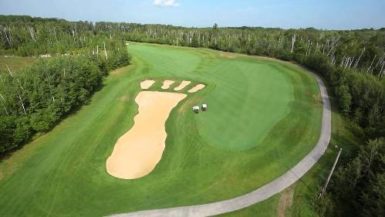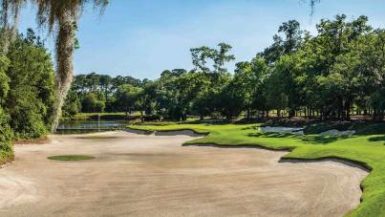11:00 – “Oh, Dino! Soup’s on!” – Preparing the Moveable Feast
Tucked in between the Sangre De Christo Mountains on one side and the Jemez Mountains on the other, there is no question the staggering grandeur of Black Mesa’s natural setting commands the player’s attention. The desolate, wrinkled rose-colored mountains are reminiscent of Turkey’s fabled conical rocks of Cappadocia which reach reverently to Heaven. The Black Mesa itself, a tall cylindrical mountain towering over the clubhouse, provides stunning views from many holes.
Moreover, while most people think desert courses are just ribbons of fairway framed by saguaro cactus, Black Mesa has far more color and texture than many of its Arizona counterparts: sagebrush and the predominant deciduous cottonwood trees share the canvas with the bright reds of Indian paintbrush, the shimmering gold of chamisa, the noble purple of aster. Apache plume, warbonnet seedhead and many other species of high desert flora offer a deep texture and bright contrast to the desolate pink rock and the green of the Kentucky bluegrass fairways and creeping bentgrass greens.
Nevertheless, Peck and Spann wanted a strategic course with solid design principles as well and, indeed, this course has as much brains as beauty. Peck and Spann sometimes joke that Black Mesa is really “Tobacco Road West” for it was an impromptu visit by Spann to Mike Strantz’s Carolina sandhills masterpiece that inspired Spann to go for broke, design outside the box, and ultimately build one of the three most critically important golf courses to open in our generation (the others are Bandon Dunes and Tobacco Road). Spann wrote in an interview with Ran Morrissett:
Just before getting into [planning] the final routing of the
course, I had played Tobacco Road. I was blown away
by the dramatic features there and by some of the chances
Mike Strantz took on the design of that course. I also
knew that many felt that TR was “over the top” or overly
severe in many places, but to me it was not any more
severe than many of the great places in Ireland or Scotland
that are revered by everyone. There just haven’t been
enough guys who are willing to risk working “on the edge”
to create something that breaks away form the routine,
formulaic golf hole design patterns that have become so
prevalent in America. Tobacco Road slapped me in the
face and made me realize what wild and exciting golf holes
can result when conventional wisdom and traditional limits
are abandoned in favor of fresh creativity and vision.
Thankfully, for the game, Peck understood and embraced the same concepts. He allowed Spann a free hand to incorporate just a few blind or semi-blind shots and design heaving, contour-filled greens as the course meanders through around and sometimes over the dramatic bleak jagged pink hills that tower over the high desert floor.
Amazingly, architect Baxter Spann only moved about 200,000 cubic yards of earth to build Black Mesa; and that includes greens, shaping, tee boxes and the practice area. “I’d say almost half of that was for the practice area” chuckles course superintendent Pat Brockwell, the mild-mannered, caterpillar-moustached legend in greenskeeping circles who spent many years at Southern Hills, site of this year’s PGA Championship. To the inestimable delight of avid golfers, Eddie drew Pat to New Mexico and together they and Spann have nurtured a wonder of the golf world. “Baxter was here more than 100 days walking the property” reminisces Pat with a serene smile. “All that time on property was pivotal in coming up with this intricate routing.”
Spann accomplished three astounding feats while moving so little earth. First, the course’s routing is outstanding: each hole looks completely different from every other, no two consecutive holes run in the same direction and all four par threes play to different points of the compass. Next, except for the twelfth hole, the bunkers are completely organic, with shapes following the existing grade of the terrain and designed as though there were blown out by the wind. Finally, Spann designed open routes to the greens and allowed the fast and firm conditions fostered by sandy soil to promote the ground game as well as the aerial game, providing more options for all skill levels.
While not “hard for hard’s sake” or unreasonably narrow like most “limited turf” Arizona desert layouts, Black Mesa is both visually intimidating and demands precision around the greens. In an age where the PGA Tour prefers oceanic, flat greens that could masquerades as helicopter landing pads, the adventure on any hole at Black Mesa only begins upon reaching the green; to use words out of Tiger Woods’ lexicon to describe the kind of greens he doesn’t like, they have elephants buried under them.
The character filled contours are not merely fanciful whims, but echo the great design features of classic courses. The green on the par-3 eighth hole is a modified punchbowl. The kidney-shaped green of the par-4 fourteenth has the same interior movement as the seventh hole at fabled Crystal Downs, the Northern Michigan masterpiece of Alister MacKenzie and Perry Maxwell. Although it looks as though you need to chip the ball over the section of rough in the kidney shape’s negative space to get from one end of the green to the other, the contours will actually filter a well planned and struck putt from one part of the green to the other. Finally, the alien-face shape of the par-5 sixteenth green calls to mind the fabled “double plateau” shape used frequently by architects Charles Blair Macdonald and Seth Raynor.
So with all this to look forward to, a singularly beautiful natural setting coupled with a fascinating design, the castaways were agog with anticipation. We piled out of our van, exchanged warm greeting as and headed to the practice tee. Even so, we so with each hole as intricate a puzzle as difficult as a Sunday New York Times crossword clue, we might as well have doused ourselves in barbeque sauce.
Next – High Noon – Supper’s Ready





Leave a reply
You must be logged in to post a comment.